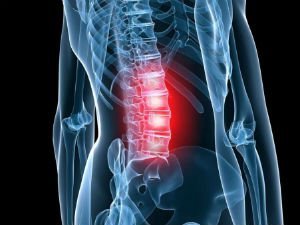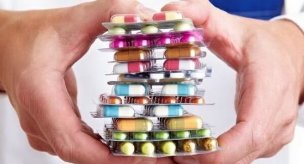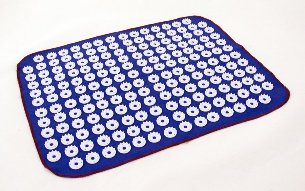
According to medical statistics, back pain in 80% of cases is caused by lumbar osteochondrosis. This occurs as a result of degenerative-dystrophic changes in this segment, when the intervertebral discs and adjacent vertebrae are affected. Osteochondrosis of the lumbar spine (OBOP) manifests itself with a variety of symptoms: pain of a different nature, limited mobility, reduced sensitivity of the lower body, etc.
To avoid dangerous complications of bone osteochondrosis (LP), you should start complex therapy in 1-2 stages of pathology. In advanced cases, when there are already irreversible changes in the disc or vertebrae, a function is performed. To prevent osteochondrosis of the lower back and related complications, it is necessary to prevent it.
Development of lumbar osteochondrosis
To understand what osteochondrosis of the lumbar spine (lumbar spine) is, you need to study the structure of the spine. It consists of vertebrae, between which cartilage pads are placed (intervertebral disc). The disc is covered with a hard fibrous membrane (annulus fibrosus), inside which is the nucleus accumbens. This structure has a shock absorption function and makes the spine more flexible.
Help. The lumbar spine is subject to tremendous stress on a daily basis, as it can support the weight of the upper body. Therefore, osteochondrosis of the lower spine is more often diagnosed than cervical, thoracic.
With regular loads on the spine, the discs contract, lose a lot of fluid, their height decreases and the distance between the vertebrae decreases. The cartilaginous lining becomes brittle, micro-alloys appear on its surface, through which the pulposus nucleus protrudes over time. With further compression of the intervertebral discs, the outer sheath ruptures and the gelatinous body falls off, thus forming a hernia. Then there is an abnormal mobility of the vertebrae, increasing the load on adjacent parts of the spine.
Shortly afterwards, bone growth (osteophytes) begins to form at the ends of the vertebral bodies. Thus, the body tries to stabilize the spine.
Doctors distinguish 4 stages of osteochondrosis of the lumbar spine:
- 1 point - problems with the discs begin, the central part becomes dehydrated, flattens, cracks appear in the outer shell. It has a deleted current. Grade 2 - cartilage cartilage, vertebrae come closer to each other, become more mobile, muscles and ligaments around the spine relax. Pain appears.
- 3 degree - protrusions, hernias and overflow of vertebrae are formed. The pain increases, the mobility is limited, the sensitivity of the lower body is disturbed. Grade 4 osteochondrosis is characterized by the appearance of osteophytes that can damage the spinal nerves and adjacent vertebrae. There is constant pain, severe neurological disorders and other complications and the risk of disability increases.
The easiest way to treat lower back chondrosis (stage 1), but diagnosing the disease at this stage is very difficult. Grade 2 intervertebral osteochondrosis is treated using conservative techniques. Surgery may be required in stages 3-4.
Help. According to statistics, OBO is most often detected in patients after 30 years. There are frequent cases of developing pathology in people after 20 years. About 80% of 60-year-old patients suffer from manifestations of this disease.
Reasons
To understand how to treat PKOP of osteochondrosis (lumbar spine), you need to know its causes:
- Normal static or dynamic load on the lumbar region. The risk group for the development of osteochondrosis includes office workers, professional athletes (weightlifting), commuters, manufacturers, etc.
- Poor posture, prolonged inappropriate posture.
- Genetic predisposition, abnormalities in the formation of vertebral bodies. This category includes youth software - curvature of the spine caused by pathologies of the spine.
- Injuries to the spine.
- Hormonal imbalance, metabolic disorders, diseases of the endocrine glands that disrupt metabolism in the lumbar region.
- Age-related changes in the body cause disc damage. TB of the bones, osteomyelitis (purulent inflammation of the bone tissue), ankylosing spondylitis (inflammation of the vertebrae and joints), rheumatoid arthritis, etc.
A disease is often caused by many causes.
In addition, there are factors that cause the development of lumbar osteochondrosis:
- Overweight.
- Passive lifestyle, prolonged sitting.
- Regular consumption of unhealthy foods (fatty, fried foods, confectionery, semi-finished products, etc. ).
- Lack of fluid, dehydration.
- Congenital disorders of the structure of the spine, for example, an extra vertebra.
- Wear uncomfortable heels regularly.
- The gestation period and then the load on the spine increases.
- Abrupt refusal to train professional athletes or excessive sports in people who have previously had a passive lifestyle.
- Smoking, frequent and excessive alcohol consumption.
There are many more factors that can cause degenerative-dystrophic processes in the lumbar spine. For example, flat feet, frequent hypothermia in the back, frequent stress, sleep disorders, etc.

Symptoms
The symptoms of lumbar spine osteochondrosis are different, depending on the stage of the pathology and the location of the affected area.
Doctors distinguish reflex and compression syndromes (symptom complex) in OBOR. The former occur when the receptors on the outer membrane of discs, ligaments, joint capsules become irritated, and the latter when nerve bundles, blood vessels, and the spinal cord are compressed.
There are such reflex syndromes of lumbar osteochondrosis:
- Lumbago. Turning pain in the lower back with sudden movement or exercise. With the slightest attempt to move, the pain syndrome intensifies, so the patient freezes in one position. The muscles in the damaged area are very tense, with palpation, the painful sensations become more intense. These manifestations are related to the movement of the nucleus accumbens within the outer shell.
- Lumbodynia. The aching pain develops for several hours or days. The discomfort increases with movement, change in body position. It weakens when a person takes a horizontal stance with a roller under the lower back. When you lift a straight leg in this position, the pain increases (Lassegh symptom). The degree of muscle tension is less than with lumbago. Lower back mobility is limited.
- Lumboischialgia. Painful sensations (sharp or aching) spread from the lower back to the lower body. There is an increase in this sign during the movements. Back pain is relieved. The muscles in the affected area are tense, the pain syndrome becomes intense on palpation.
Symptoms of compression syndromes depend on the parts of the lumbar region that have been damaged. The characteristic points are associated with the compression of the spinal nerves by hernias, osteophytes, displaced vertebrae. This condition is called rhizopathy, in which the pain increases with the slightest movement, the muscles of the lower back are stretched and mobility is limited.
Clinical manifestations of compression syndromes depending on the damaged lumbar vertebrae:
- L1 - L3 - pain and numbness in the lumbar region, front and inner thigh, the patient finds it difficult to bend / unblock the leg at the knee.
- L4 - pain syndrome extends to the front of the thigh, descends to the knee (back). In the same area, the sensitivity is disturbed.
- L5 - the painful sensations radiate to the buttocks, the outside of the thigh, go down along the front of the lower leg to the inside of the foot and the big toe. In the same area, he feels numbness, it is difficult for the patient to bend his finger.
- S1 - the pain spreads from the lower back to the buttocks, the outside and the back of the thigh, descends to the outside of the lower leg, the foot. In the same areas, numbness is felt, the muscles of the lower leg weaken, so it is difficult for the patient to stand on his toes.
There is a risk of damage to several nerve bundles at the same time, for example, L5, S1. If the hernia moves backwards, it can compress the spinal cord.
Compression of the blood vessels in the lower back increases the likelihood of weakening of the leg muscles, numbness of the lower extremities, reduced control of the process of urination and defecation. In men with OBO, erections weaken and in women, the main symptoms may be supplemented by inflammation of the ovaries or uterus.
Diagnostic measures
To diagnose OBO, the doctor examines the patient, palpates the patient to determine the condition of the muscles, and to locate the curvature of the spine. It is important to tell your specialist in detail about your symptoms to make it easier to diagnose.
Organic tests will help diagnose intervertebral osteochondrosis:
- Radiography of the lower back (frontal and lateral projection).
- Computed tomography and magnetic resonance imaging.
X-rays allow you to evaluate the structure of the EPP. To detect abnormal mobility of the vertebrae, X-rays are taken at flexion and extension sites. This study allows us to observe that the intervertebral fissure has shrunk, the vertebral bodies have shifted, and osteophytes have appeared at their edges. However, this diagnostic method is considered obsolete.
Today, CT and MRI scans are increasingly used to detect degenerative-dystrophic changes in the spine. These highly informative studies allow the assessment of the condition of the vertebrae, discs, intervertebral load and spinal cord. With their help, the protrusions, the direction of the hernia, the degree of compression of the nerve ties, the spinal cord and the blood vessels are identified.Treatment
MEDICINES FOR FACIAL OCEOSHONDRATION

Treatment of EPP osteochondrosis lasts from 1-3 months to 1 year. The success of the treatment depends on the patient himself, who must strictly follow the doctor's recommendations. With self-medication, the patient's condition usually worsens.
Treatment goals:
- Stop or alleviate software symptoms.
- Determine the cause of the disease, try to exclude it from life.
- Eliminate the inflammatory process.
- Restore blood circulation, metabolic processes in the lumbar spine.
- Try to improve the condition of the damaged cartilage, to stop further degenerative changes.
To achieve such goals, it is recommended to perform complex therapy. It usually starts with taking medication:
- Muscle relaxants. They relax the muscles and relieve pain and inflammation.
- NSAIDs. They have anti-inflammatory, analgesic, antipyretic effects.
- Antispasmodics. They help to stop the spasm of the smooth muscles, in the relief of the pain.
- Anesthetics. They are used for severe pain syndrome in the form of therapeutic exclusion.
- Glucocorticosteroids. They also help treat pain. However, these drugs are capable of damaging the bones, so they are taken for a short time and only after a doctor's approval.
- Sedatives. They relieve neuromuscular tension, improve sleep.
- Vitamins (group B, E, C, A). Restores the condition of the affected nerves, relieves pain.
Attention. NSAIDs should not be taken for gastritis or stomach ulcers, as they further damage the lining of the gastrointestinal tract.
In case of deterioration, the patient receives injections and after relief of the main symptoms, takes oral medication.
In addition, external agents (gels, ointments, creams, scrubs) are used.
The question of what to do in case of chronic osteochondrosis of the back is quite important. If OBOP has been in place for years, then after relieving the main symptoms, the patient is prescribed chondroprotectants, drugs that restore blood circulation, drugs based on B vitamins. They help restore hydration, normalize blood supply to the affected area andin preventing further development of pathology.
Treatment of lumbar spine chondrosis (stage 1) is carried out with the use of chondroprotectors, which slow down the development of degenerative processes, accelerate the regeneration of cartilage. In addition, the patient is prescribed complexes of vitamins and minerals. This form of osteochondrosis is the easiest treatment.
OTHER MAINTENANCE TECHNIQUES
In case of acute chronic disease (osteochondrosis) of 1-2 degrees, the following treatment procedures will help to stop its development:
- Ultrasound treatment relieves pain and inflammation and normalizes blood flow to the damaged area.
- Detector therapy is a safe traction of the spine due to the weight of the body itself, after which muscle tone is normalized and mobility is improved.
- Magnetotherapy reduces pain and inflammation of the muscles around the spine. Reflexology (insertion of needles into bioactive points in the body) speeds up blood circulation, relieves inflammation and swelling.
- Manual therapy (effect on the affected area with a doctor's hands) and massage normalizes muscle tone, reduces compression of nerve bundles, improves nutrition of the intervertebral discs and restores the structure of the spine.
- Electrophoresis allows the delivery of drug solutions through the skin to the tissues of bones and cartilage.
- Drasonvalization improves blood circulation, metabolic processes, reduces pain, restores skin sensitivity.
There are many more effective procedures that will help improve the patient's condition in 5-15 sessions. The main thing is to get the doctor's approval before performing them.
HOME SOFTWARE TREATMENT
If you are wondering if OBO can be treated at home, talk to your doctor. If the specialist has given permission, start treatment, which usually consists of the following points:
- Nutrition. If lumbar osteochondrosis is caused by decreased blood flow or metabolism, exclude fatty, fried, spicy foods, eggs, etc. from the menu. Fill the menu with fresh vegetables, fruits, lean meat, fish, dairy products. Stop alcohol, tonics (tea, coffee). Drink filtered water, compotes, herbal tea.
- To restore blood circulation, apply or apply rubbing and compressions.
- Sleep on an orthopedic mattress, a low pillow. If you have a sedentary job, buy a chair with a backrest that will support your spine. Wear special corsets or belts from time to time.
- Exercise therapy will help strengthen the muscular corset, will relieve part of the load from the disease of the spine. The band for each patient is compiled separately by a doctor or trainer.
- Do a self-massage in the lumbar region. However, ask a professional how to do it right.
- Use folk remedies in the form of rubs, compresses, baths, etc.
- The needle application is a plastic plate with many thorns, which improves blood circulation, metabolic processes in the affected area, reduces muscle pain and relaxes.

And also at home you can use lotions with herbal decoctions, plasters.
Help. An innovation in the treatment of osteochondrosis is a massage bed that is suitable for even the most disorganized patients.
However, keep in mind that home remedies can only be done with your doctor's permission.
SURGICAL TREATMENT
Bone osteochondrosis surgery is recommended if conservative techniques have been shown to be ineffective for a long time. Also, surgery is indicated for involuntary urination, defecation and cauda equina syndrome (stinging of the nerves of the lower spinal cord).
The following surgical methods are used to treat OBO:
- Spinal fusion - fusion of adjacent vertebrae.
- Facetextomy - removal of the intervertebral joints that pinch the spinal nerve.
- Lamidectomy is the removal of the plate that covers the spinal canal that compresses the spinal cord. Discectomy is the complete or partial removal of an intervertebral disc that causes compression of the nerve root or spinal cord.
- Correctomy - removal of the vertebral body and adjacent cartilage patches. The empty space is then filled with a bone graft and 3 vertebral sections are fused.
Help. After surgery, there is a risk of complications: spinal cord injuries, nerve bundles, broken grafts, infections, etc.
After treatment, you need to undergo rehabilitation to speed up your recovery.
Complications
In the absence of appropriate treatment, the risk of such complications of osteochondrosis increases:
- Itchy disc, rooted nerve root or spinal cord. Prolonged inflammation increases the chance of developing radiculitis (inflammation of the nerve roots). Sciatica (inflammatory damage to the sciatic nerve), in which there is severe pain and numbness in the lower extremity.
- In case of reduced blood circulation in the spinal cord, the possibility of compression myelopathy increases (compression of the spinal cord by various formations: bone fragments, hernia, tumors, hematoma).
- Cauda equina syndrome - compression of the roots of the lower spinal cord, which leads to reduced function of the intestines, pelvic organs and lower extremities.
To avoid such complications, you should start treatment as soon as possible.
Prevention
To avoid bone osteochondrosis, follow these rules:
- Follow a moderately active lifestyle (walk more often, exercise regularly, sign up for a pool).
- For sedentary work, warm up every 1. 5 hours.
- Sleep on an orthopedic mattress.
- Avoid excessive physical exercise, lift weights only from the half-standing position, before that, wear a special belt on your lower back.
- Buy orthopedic shoes.
- Eat right, take vitamin and mineral complexes as directed by your doctor.
- Learn to relax.
- Try not to hypothermically.
- Deal with diseases that can cause OBO in a timely manner.
- Stop bad habits.
By following these recommendations, you can avoid degenerative changes in the spine and improve your health.
The most important
If you notice symptoms of osteochondrosis, see a doctor immediately. Self-medication can make your condition worse and cause complications. Lumbar cartilage (stage 1) is treated with exercise therapy, physiotherapy and chondroprotectors. In later stages, medicines, massage, manual therapy, etc. are used. In the absence of positive dynamics for a long time or the appearance of neurological symptoms, the doctor may prescribe surgery. The patient must strictly follow the doctor's recommendations to speed up recovery.





































